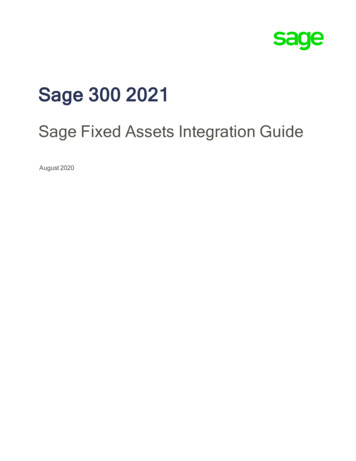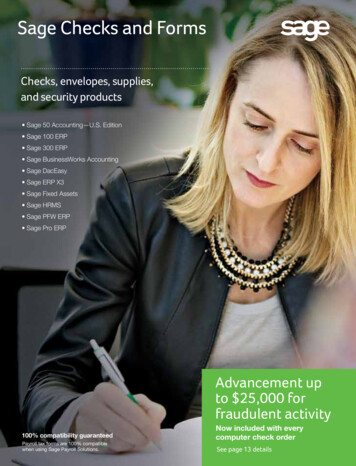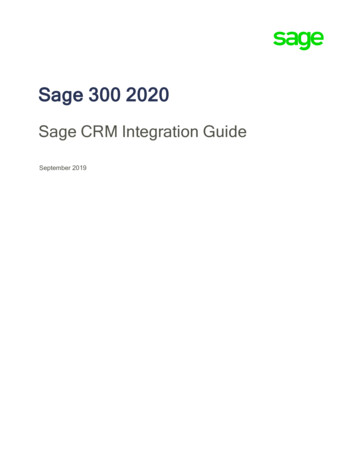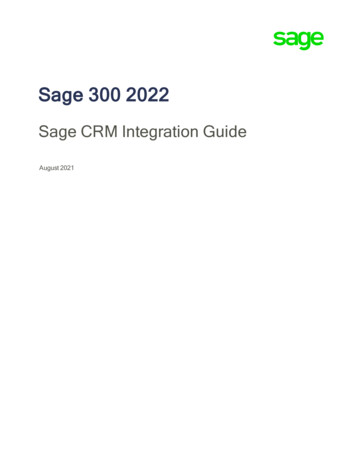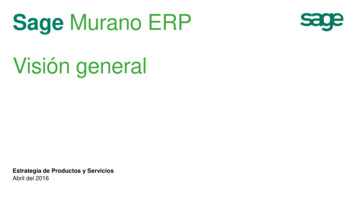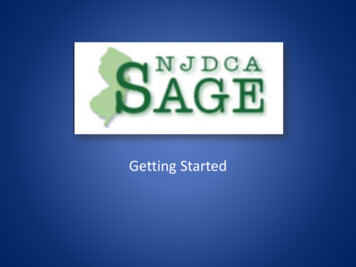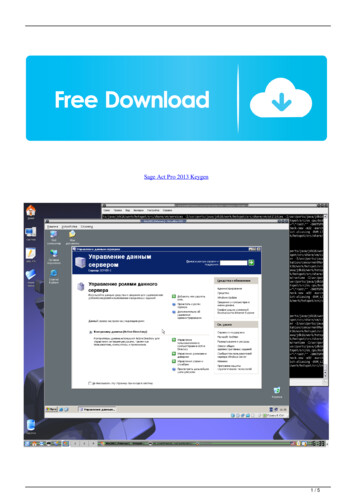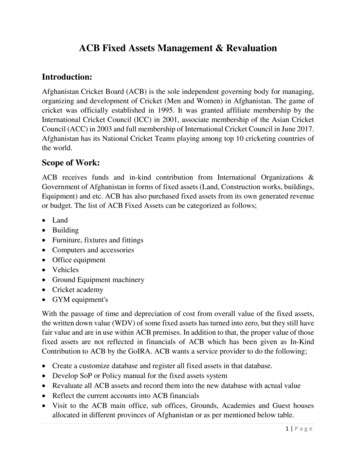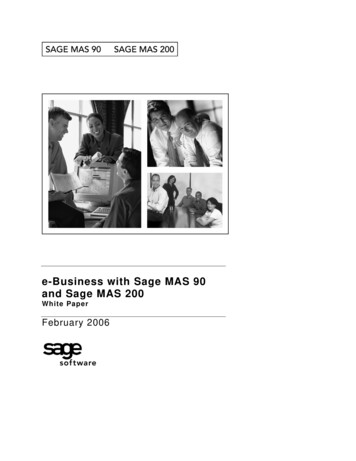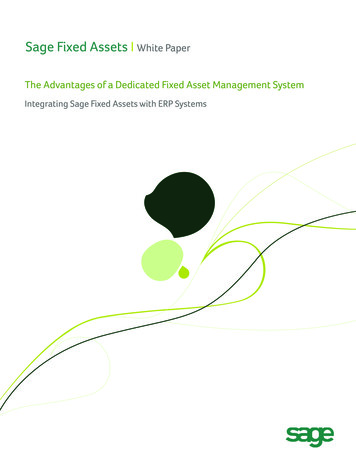
Transcription
Sage Fixed Assets I White PaperThe Advantages of a Dedicated Fixed Asset Management SystemIntegrating Sage Fixed Assets with ERP Systems
Table of ContentsSage Fixed AssetsIntroduction .3Two Approaches to Fixed Asset Management .4At a Glance: ERP Fixed Assets vs. Dedicated Fixed Asset Systems .5Advantags of Managing Fixed Assets with Sage Fixed Assets .6Timely Updates to Address Changing Tax Laws .6More Robust Capabilities .6Ready to Address the Challenge .7Ease of Use and Superior Efficiency .8Lower Costs .8Easy Communication with External Accounting Firms and Auditors .8The Best of Both Worlds - Sage Fixed Assets Integration with ERP .9Sage Fixed Assets Universal Link .9Complimentary Sage Fixed Assets Links for Sage Software ERP and GL Solutions .10Prebuilt Custom Integrations .10Conclusion .11This report is informational only and not meant asaccounting, tax, or legal advice. Exceptions andspecial provisions are not covered, so you shouldconsult your accounting, tax, or legal professionalsfor advice specific to your situation.The Advantages of a Dedicated Fixed Asset Managemen System2
IntroductionSage Fixed AssetsWhen businesses implement Enterprise Resource Planning (ERP) systems, they also face the decisionof whether to manage fixed assets using an add-on module from the ERP vendor or a dedicated fixedasset management solution. While ERP systems are excellent at integrating financial information andautomating customer order data, fixed asset management is not the main development focus of ERPvendors, and an add-on module does not contain the robust feature set of a dedicated solution.Sage delivers the tools necessary to gain complete control over the entire lifecycle of fixed assetsas well as address the growing number of compliance concerns. Sage Fixed Assets is a family ofintegrated, award-winning fixed asset management solutions used by over 100,000 fixed assetprofessionals and the Top Ten U.S. accounting firms. Providing customers with total control over fixedasset management is the dedicated focus of Sage Fixed Assets research and development efforts.Sage has created this guide to provide fixed asset managers who currently use Sage Fixed Assetswith information to make the business case for integrating Sage Fixed Assets with your ERP system.In addition, if you’re currently searching for a fixed asset management solution, this guide will explainwhy a best-of-breed fixed asset management solution, such as Sage Fixed Assets, may be a moreaffordable, flexible, and reliable option than an ERP add-on module.This guide illustrates precisely how Sage Fixed Assets integrates with ERP systems to providebusinesses with the best of both worlds in fixed asset and financial management. It also details themany benefits companies can enjoy by combining Sage Fixed Assets with existing ERP systems.These benefits include: Regular tax updates More robust functionality Cost savings Knowledgeable support from depreciation experts Enhanced complianceThe Advantages of a Dedicated Fixed Asset Managemen System3
Two Approaches to Fixed Asset ManagementSage Fixed AssetsThe day-to-day management of fixed assets is a critical business function—one not easily understoodoutside the accounting and finance departments. The top-down nature of the decision to implement anERP system often does not specifically consider the unique requirements of fixed asset managers. Yetincomplete or inaccurate fixed asset management and reporting can negatively impact the bottom linewith overpaid taxes and insurance, and potentially cause corporate compliance failures.Essentially, there are two approaches to managing fixed assets in an ERP information environment. Thefirst is to implement an add-on module from your ERP vendor. However, the main focus for manyadd-ons is the integration, not the features and functions required to plan for the most strategic use ofassets and make positive impacts on the financial well-being of the company.The second approach involves using a dedicated fixed asset management solution that is morefully-featured and feeds important fixed asset depreciation data to your ERP system. Through dataintegration, both ERP add-on modules and dedicated fixed asset solutions can transfer fixed assetdata among the fixed asset system, the General Ledger (GL), and other business functions, such asAccounts Payable (AP) and Purchasing. (You’ll learn how the integration works later in this guide.)For businesses facing the decision between implementing a dedicated fixed asset managementsystem, such as Sage Fixed Assets or adding an ERP module, the key differentiating factors are:functionality, ease-of-use, cost, and compliance issues. And as outlined in the next section, dedicatedfixed asset management solutions offer advantages in each of these areas.The Advantages of a Dedicated Fixed Asset Managemen System4
At a Glance: ERP Fixed Assets vs. Dedicated Fixed Assets SystemsERP Fixed Asset ModulesEase of UseInterfaceSimple Tasks can take many steps.and lead through several screensCreated to match ERP system, notproduce better productivity for fixedasset managers.Technical SupportFunctionality BeyondDepreciationSage Fixed AssetsDedicated Fixed Asset SystemTasks fewer steps and less time–screens are designed to pull in allthe necessary information quickly.Planned and developed to aidefficiency of fixed asset managers.Personnel not well-versed in theTrained only to support fixed assetintricacies of depreciation.accounting.Primarily address tax, lackingAddress the complete lifecycle ofadvanced features for inventory orassets, including construction inconstruction in progress.progress and physical inventories.Include much larger selectionReportingOnly basic fixed asset reportsof useful fixed asset reports inare included. Creating customizedthe standard system.reports (while the data is abundant)Most include a report generatorcan be complicated and oftenrequires the help of consultantsand/or your IT department.that enables fixed asset managersto create their own custom reportsand, in some cases, to modifystandard reports.High–often requiring expensiveCostconsulting engagements to set up,modify, or implement tax lawAffordable–designed for the needsand budgets of small and mediumsized businesses.changes.Depreciation tax law changes takea long time to be incorporated, if atall. Consultants are often required.Tax Law ComplianceDepreciation changes built nto ageneral release might be blockedVendors provide timely softwareupdates to reflect tax law changesas part of support plan.by your IT department, if the updateimpacts multiple departments.Sarbames-Oxley ComplianceCompliance concerns generallySecurity controls limit access tofocused on general ledger andfixed asset data and track whoaccounting areas, rather than fixedmakes changes at the individualassets.asset level.The Advantages of a Dedicated Fixed Asset Managemen System5
Advantages of Managing Fixed Assets with Sage Fixed AssetsSage Fixed AssetsWhile fixed asset management is a tiny part of what ERP research and development teams work on,it is the exclusive focus of dedicated fixed asset systems such as Sage Fixed Assets. The Sage FixedAssets development, quality assurance, professional services, and customer support teams all receiveextensive training in the intricacies of depreciation. The Sage Fixed Assets team includes depreciationexperts and CPAs who ensure that the solution stays abreast of changing tax laws and addresses thekey concerns of fixed asset managers in the most efficient, reliable, and precise way.“Thanks to Sage Fixed Assets- Premier Depreciation SQLServer, we saved 1 million intaxes—a significant opportunityTimely Updates to Address Changing Tax Lawswe’d have lost if we waited toCustomers trust Sage Fixed Assets for total accuracy in their depreciation calculations. The availabilityupgrade our ERP system. And,of regular updates when tax laws change is a key difference between Sage Fixed Assets and add-onbecause it’s so easy to do taxmodules from ERP vendors. At Sage, a team of depreciation experts monitors all tax law changes andreporting in Sage Fixed Assets,immediately goes to work incorporating them into the next release of Sage Fixed Assets. An annual taxwe also save about 10,000 inupdate incorporating all of the pertinent tax law changes for the next tax filing is released at the end ofaudit fees every year.”each year. Additionally, other releases of the software provide product enhancements and further taxlaw changes if new rules are announced midyear. These updates are free of charge to customers on aSage Fixed Assets.ERP vendors do not always schedule software releases based on tax law changes. That is becausemost software updates will impact multiple software modules and business units. When Congresschanges a tax law, your ERP vendor is unlikely to respond immediately, if ever. This leaves fixed assetJohn GarbaciakVice President of FinancialReportingEdelman Public RelationsWorldwidemanagers in the unenviable position of having to stay abreast of changing regulations and determinehow each new law impacts your business. If your ERP vendor does offer a patch to address a tax lawchange, you run the risk of this fix impacting other areas of the organization. Without a timely release,you may have to pay consultants to update your fixed asset module to reflect current tax law orcompliance regulations.More Robust CapabilitiesWhen selecting a fixed asset management solution, it’s important to find one that addresses the keyduties of fixed asset managers throughout the lifecycle of fixed assets. Consider your company’sneeds: What advanced fixed asset accounting features will you require? Are all of the tax forms that you will need to produce automated? Do you need to track and manage invoices and budget during work-in-progress projects before anew fixed asset is created? Will you take routine physical inventories of fixed assets? What types of reports and projections will management expect? Or the auditor?Inventory of fixed assets is the only way to ensure that the assets on your books are the same onesdistributed throughout your company. Without regular inventories, you could waste thousands ofdollars paying taxes and insurance on lost, stolen, or out-of-service assets. Many ERP fixed assetmodules don’t address the need for physical fixed asset inventories. Those that do often lack essentialfunctionality such as ability to use barcode labels and handheld readers, with data automaticallyreconciled against the central database of fixed assets.financial health of any company.The Advantages of a Dedicated Fixed Asset Managemen System6
Construction-in-progress functionality (also called work in progress) helps you to track, organize, andSage Fixed Assetsmonitor the construction costs against budget. ERPs do not consider this aspect of the fixed assetlifecycle because it occurs prior to placing an asset in service. However, this stage of production of afixed asset can be very important to your business.Ready to Address the ChallengeThanks to their exclusive focus on fixed assets, Sage Fixed Assets solutions have the most complete“It’s nice to know that Sagefeature sets available today. Perhaps the most defining feature of Sage Fixed Assets solutions is theirSoftware has a staff of CPAscomprehensive management of the entire fixed asset lifecycle, from construction in progress projectsand experts that are constantlythrough disposal.monitoring and interpretingSage Fixed Assets - Depreciation provides advanced fixed asset accounting and reporting features forbusinesses needing effective decision-making tools in integrated accounting environments. For largerbusinesses with greater volumes of assets, Microsoft SQL Server options add more speed, power,new tax rules. With Sage FixedAssets - Depreciation, all I haveto do is install the softwareand flexibility. Chosen three to one over competing fixed asset management solutions combined, Sageupdate to know that Bell &Fixed Assets - Depreciation features the most robust functionality in the industry, including:Gossett is in full compliance Most comprehensive depreciation calculation engine in the industry, with over 300,000 IRS tax andGAAP rules built in Seven books, all visible on one screen—Internal, Tax, ACE, AMT, State, and two user-definedcustom bookswith the latest tax legislation.”Dan LeiderSenior AccountantBell & Gossett Management over the entire fixed asset lifecycle, including transfers and disposals Automatic calculation of AMT and ACE schedules Over 50 standard depreciation methods—including MACRS 150 percent and 200 percent(formulas and tables), ACRS, Straight Line, Modified Straight Line (formulas and tables), DecliningBalance, Sum-of-the-Years-Digits, and customized depreciation methodsSage Fixed Assets - Tracking delivers unparalleled asset inventory tracking and reconciliationcapabilities. Using state-of-the-art bar code technology—including Windows Mobile bar code readingdevices—it creates and tracks physical inventories quickly and accurately for better management offixed assets.Barcode Readers and Labels provide a complete fixed asset inventory solution, all available from onevendor. Combining these hardware tools with the Sage Fixed Assets software solution delivers aninstant return on investment.Sage Fixed Assets - Planning helps control spending and streamlines project accounting prior toplacing a fixed asset in service. It eliminates cumbersome spreadsheets, manual data entry, and themountain of invoices associated with assembling multicomponent equipment, upgrading machinery,constructing buildings, and other work in progress.Sage Fixed Assets - Reporting provides control over the format, appearance, and context of alldepreciation and asset management reports. With the point-and-click system of Sage Fixed Assets Reporting, it is easy to create professional, custom reports instantly and even share fixed asset datawith other programs using the built-in ASCII and spreadsheet exports.Sage Fixed Assets Compliance Advisor produces a multitude of comprehensive reports that satisfythe most common information requests posed by auditors during an evaluation of internal controls forSection 404 of the Sarbanes Oxley Act.The Advantages of a Dedicated Fixed Asset Managemen System7
Sage Fixed AssetsEase of Use and Superior EfficiencySage Fixed Assets is easy to implement, learn, and use. Every feature is designed to help fixed assetmanagers accomplish routine tasks in fewer steps. The information that you need is arranged foreasiest access, with all seven books available on one screen. Other features include: Easy-to-use graphical interface Fully customizable data entry screen including field names, lengths, pictures, and prompts—fieldscan even be turned off completely Customizable “SmartLists” for fast, accurate asset entry“One of the main benefits ofimplementing a fixed assetsolution comes from inventoryreconciliation. When we assess a Powerful “Group Manager” for instant queries and reusable group definitionscompany’s inventory, it’s not “Group View” for working with and viewing multiple assets simultaneouslyunusual for us to find that an “Tab Design” lets you instantly switch between “Main,” “Transfer,” and “Disposal” functionsfixed assets have actually beenCommonly used functions like transfers or disposals that might take seven to nine steps in the add-onaverage of 15 to 30 percent of theretired, sold, discarded or are notmodule from your ERP vendor take two or three quick clicks of your mouse in Sage Fixed Assets.in use.”1Every step that can be consolidated in your daily routine tasks is time saved. Customers who have triedScott Swartsboth solutions say these little time-savings add up to a much more efficient work day with Sage FixedPresidentAssets.Paragon SystemsLower CostsCIO Magazine lists training, implementation, customization, and consultants among the “hidden costsof ERP” that often surprise companies implementing a new ERP.1 With Sage Fixed Assets you cansave on all of these expenses.Sage Fixed Assets is designed to be an out-of-the-box solution that can be implemented by thecustomer. A friendly, wizard-driven interface helps new users step by step through the implementationprocess. If you require additional assistance, the Sage Fixed Assets customer support and professionalservices teams stand ready to help, dedicated solely to supporting, training, and assisting Sage FixedAssets customers.Similarly, regular Sage Fixed Assets updates also install quickly, so you’ll be able to take advantage ofeach new feature and stay compliant with every change in the tax code. New features in ERP systemsoften bring new fees. Installing the patches and updates for ERP systems often require the help ofconsultants and can impact multiple business units.Affordable Sage Fixed Assets training is delivered in three different formats to match the schedulesand training budgets of all Sage Fixed Assets customers. Training is available online, in classroomsnationwide, or on location at the customer’s request.A wide range of training is available, from basic “getting started” classes to very advanced fixed assetmanagement techniques.Easy Communication with External Accounting Firms and AuditorsBecause Sage Fixed Assets solutions are widely used by thousands of CPAs and the top tenaccounting firms in the nation, it is easy to exchange Sage Fixed Assets data with your externalaccounting firm and compliance auditors.1 Christopher Koch, “The ABCs of ERP,”CIO.com Enterprise Resource Planning Research Center. www.cio.com/research/erp/edit/erpbasics.html ,accessed on June 9, 2006The Advantages of a Dedicated Fixed Asset Managemen System8
Sage Fixed AssetsThe Best of Both Worlds - Sage Fixed Assets Integration with ERPIt is easier than ever to take advantage of all the benefits offered by Sage Fixed Assets while still fullyutilizing your ERP system. Rapid improvements in data integration over the past several years make itmuch easier for systems to communicate than ever before.Sage has a great deal of experience integrating ERP systems with other applications. So it shouldcome as no surprise that our customers routinely integrate Sage Fixed Assets with their ERPsystems— it’s easy to accomplish! Sage Fixed Assets can transfer fixed asset information to your ERPsystem in one of several ways:Sage Fixed Assets Universal LinkThe Sage Fixed Assets Universal Link provides for the transfer of fixed asset data from SageFixed Assets to any general ledger package that accepts data in an ASCII format, including ERPsystems such as SAP , Oracle , and PeopleSoft . The Sage Fixed Assets Universal Link providesinexpensive, open integration to any system, enabling you to import and export fixed asset data quicklyand easily. Best of all, it features an easy setup, so end-users can install it without assistance—noconsultants required! You enjoy the best of both worlds: The robust functionality of Sage Fixed Assetscombined with the power and automation of your ERP.If you desire even deeper integration between Sage Fixed Assets and your ERP system, SageProfessional Services stands ready to help. They can design fully automated, scalable integrationsusing any of the data stored in the Sage Fixed Assets database. For example, you could send datafrom Accounts Payable into Sage Fixed Assets, and then send data from Sage Fixed Assets to postdepreciation journal entries on your General Ledger. Here’s how it works:Data easily flows from Sage Fixed Assets through the Sage Fixed Assets Universal Link into yourGeneral Ledger or other Accounting System.The Advantages of a Dedicated Fixed Asset Managemen System9
Complimentary Sage Fixed Assets Links for Sage ERP and General LedgerSolutionsSage Fixed AssetsSage Fixed Assets provides dedicated integration to other Sage solutions at no additional cost. SageFixed Assets Links provide accurate depreciation expense journal entries by automating the postingprocess between Sage Fixed Assets and your general ledger.Using the Sage Desktop, a virtual common workspace deployed across Sage solutions, Sage FixedAssets users can quickly access all applications, information, and tasks they need for work processes.Simply select the built-in Sage Fixed Assets Link from the Sage Fixed Assets menu for an easy,accurate, and dependable way to post summary depreciation expenses. You can even verify theaccuracy between Sage Fixed Assets and your general ledger with a dependable posting report that isgenerated every time you send Sage Fixed Assets depreciation data to your General Ledger.Sage Fixed Assets Links come preinstalled in Sage Fixed Assets - Depreciation. Currently, built-in SageFixed Assets Links exist for: Sage Accpac ERP Sage BusinessWorks Accounting Sage BusinessVision Sage MAS 90/200 ERP Sage MAS 500 ERP Sage MIP Fund Accounting Sage PFW ERP Sage Pro ERP Sage Timberline Office Microsoft Dynamics SL Peachtree by Sage - Quantum QuickBooks Simply Accounting by SagePrebuilt Custom IntegrationsPrebuilt custom integrations exist so that you can transfer data between Sage Fixed Assets and thirdparty products such as CCH ProSystem . These integrations are available at a nominal cost fromSage and third-party consultants and enable you to automate the seamless transfer of fixed asset datafrom Sage Fixed Assets to another accounting tool.The Advantages of a Dedicated Fixed Asset Managemen System10
Sage Fixed AssetsConclusionWith over 300,000 IRS tax and GAAP rules built in, more than 50 supported depreciation methods, anda team of depreciation experts to produce an annual tax update, Sage Fixed Assets delivers the goldstandard of accuracy in fixed asset accounting. But Sage Fixed Assets solutions address the entirerange of fixed asset management duties, not just depreciation for tax. Sage Fixed Assets customersalso gain control over fixed asset inventory, construction in progress, and compliance. Advancedreporting provides critical insight to help management make strategic decisions about fixed assets.Sage Fixed Assets solutions are designed to grow with your business. The fully integrated modulescan be purchased and installed as your company’s needs grow or budget allows. Every Sage FixedAssets solution is available for Microsoft SQL to add speed, power, and scalability for rapidly growingbusinesses. When combined through the easy integration of Sage FAS Universal Link, your ERPsystem and Sage Fixed Assets will make a powerful combination.In conclusion, your decision-making process for selecting a fixed asset management system shouldinvolve a careful evaluation of the benefits of both dedicated fixed asset solutions and add-on modulesfor your ERP system. Integration is not the only factor to consider. The extra boost to your company’sbottom line achieved through accurate, strategic management across the entire fixed asset lifecycleshould encourage you to evaluate the enhanced functionality, ease of use, better compliance, and costsavings of Sage Fixed Assets solutions.The Advantages of a Dedicated Fixed Asset Managemen System11
Sage2325 Dulles Corner BlvdSuite 700Herndon, VA 20171800-368-2405www.SageFixedAssets.com 2011 Sage Software, Inc. All rights reserved. Sage, the Sage logo, and the Sage product and service names mentioned hereinare registered trademarks or trademarks of Sage Software, Inc., or its affiliated entities. All other trademarks are the property of theirrespective owners.09-16691 11/11
Sage has created this guide to provide fixed asset managers who currently use Sage Fixed Assets with information to make the business case for integrating Sage Fixed Assets with your ERP system. In addition, if you're currently searching for a fixed asset management solution, this guide will explain
